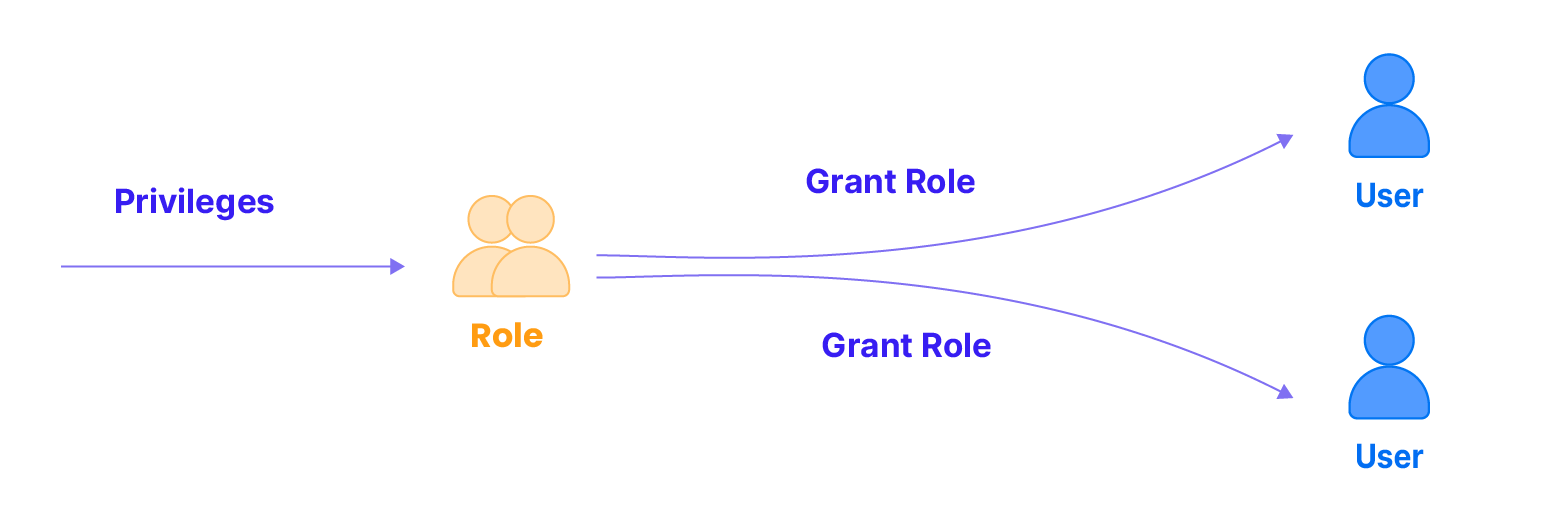Roles
Roles in Databend play a pivotal role in simplifying the management of permissions. When multiple users require the same set of privileges, granting privileges individually can be cumbersome. Roles provide a solution by allowing the assignment of a set of privileges to a role, which can then be easily assigned to multiple users.

Inheriting Roles & Establishing Hierarchy
Role granting enables one role to inherit permissions and responsibilities from another. This contributes to the creation of a flexible hierarchy, similar to the organizational structure, where two Built-in Roles exist: the highest being account-admin and the lowest being public.
Consider the scenario where three roles are created: manager, engineer, and intern. In this example, the role of intern is granted to the engineer role. Consequently, the engineer not only possesses their own set of privileges but also inherits those associated with the intern role. Extending this hierarchy further, if the engineer role is granted to the manager, the manager now acquires both the inherent privileges of the engineer and the intern roles.

Built-in Roles
Databend comes with the following built-in roles:
| Built-in Role | Description |
|---|---|
| account-admin | Possesses all privileges, serves as the parent role for all other roles, and enables seamless switching to any role within the tenant. |
| public | Inherits no permissions, considers all roles as its parent roles, and allows any role to switch to the public role. |
To assign the account-admin role to a user in Databend Cloud, select the role when inviting the user. You can also assign the role to a user after they join. If you're using Databend Community Edition or Enterprise Edition, configure an account-admin user during deployment first, and then assign the role to other users if needed. For more information about configuring admin users, see Configuring Admin Users.
Setting Default Role
When a user is granted multiple roles, you can use the CREATE USER or ALTER USER commands to set a default role for that user. The default role determines the role automatically assigned to the user at the beginning of a session:
-- Show existing roles in the system
SHOW ROLES;
┌───────────────────────────────────────────────────────────┐
│ name │ inherited_roles │ is_current │ is_default │
├───────────────┼─────────────────┼────────────┼────────────┤
│ account_admin │ 0 │ true │ true │
│ public │ 0 │ false │ false │
│ writer │ 0 │ false │ false │
└───────────────────────────────────────────────────────────┘
-- Create a user 'eric' with the password 'abc123' and set 'writer' as the default role
CREATE USER eric IDENTIFIED BY 'abc123' WITH DEFAULT_ROLE = 'writer';
-- Grant the 'account_admin' role to the user 'eric'
GRANT ROLE account_admin TO eric;
-- Set 'account_admin' as the default role for user 'eric'
ALTER USER eric WITH DEFAULT_ROLE = 'account_admin';
- Users have the flexibility to switch to other roles within a session using the SET ROLE command.
- A user can examine their current role and view all the roles granted to them by using the SHOW ROLES command.
- If you don't explicitly set a default role for a user, Databend will default to using the built-in role
publicas the default role.
Active Role & Secondary Roles
A user can be granted multiple roles in Databend. These roles are categorized into an active role and secondary roles:
-
The active role is the user's currently active primary role for the session, which can be set using the SET ROLE command.
-
Secondary roles are additional roles that provide extra permissions and are active by default. Users can activate or deactivate secondary roles with the SET SECONDARY ROLES command to temporarily adjust their permission scope.
Billing Role
In addition to the standard built-in roles, you can create a custom role named billing in Databend Cloud to cater specifically to the needs of finance personnel. The role billing provides access only to billing-related information, ensuring that finance personnel can view necessary financial data without exposure to other business-related pages.
To set up and use the role billing, you can create it using the following command:
CREATE ROLE billing;
The role name is case-insensitive, so billing and Billing are considered the same. For detailed steps on setting and assigning the role billing, see Granting Access to Finance Personnel.
Usage Examples
This example showcases role-based permission management. Initially, a 'writer' role is created and granted privileges. Subsequently, these privileges are assigned to the user 'eric', who inherits them. Lastly, the permissions are revoked from the role, demonstrating their impact on the user's privileges.
-- Create a new role named 'writer'
CREATE ROLE writer;
-- Grant all privileges on all objects in the 'default' schema to the role 'writer'
GRANT ALL ON default.* TO ROLE writer;
-- Create a new user named 'eric' with the password 'abc123'
CREATE USER eric IDENTIFIED BY 'abc123';
-- Grant the role 'writer' to the user 'eric'
GRANT ROLE writer TO eric;
-- Show the granted privileges for the user 'eric'
SHOW GRANTS FOR eric;
┌──────────────────────────────────────────────────┐
│ Grants │
├──────────────────────────────────────────────────┤
│ GRANT ALL ON 'default'.'default'.* TO 'eric'@'%' │
└──────────────────────────────────────────────────┘
-- Revoke all privileges on all objects in the 'default' schema from role 'writer'
REVOKE ALL ON default.* FROM ROLE writer;
-- Show the granted privileges for the user 'eric'
-- No privileges are displayed as they have been revoked from the role
SHOW GRANTS FOR eric;